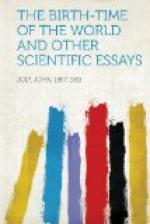In any quarry where a section of the soil and of the underlying rock is visible, we may study the mode of formation of soils. Our observations are, we will suppose, pursued in a granite quarry. We first note that the material of the soil nearest the surface is intermixed with the roots of grasses, trees, or shrubs. Examining a handful of this soil, we see glistening flakes of mica which plainly are derived from the original granite. Washing off the finer particles, we find the largest remaining grains are composed of the all but indestructible quartz.
[1] Proc. Roy. Irish Acad., VIII., Ser. A, p. 21.
37
This also is from the granite. Some few of the grains are of chalky-looking felspar; again a granitic mineral. What is the finer silt we have washed off? It, too, is composed of mineral particles to a great extent; rock dust stained with iron oxide and intermixed with organic remains, both animal and vegetable. But if we make a chemical analysis of the finer silt we find that the composition is by no means that of the granite beneath. The chemist is able to say, from a study of his results, that there has been, in the first place, a large loss of material attending the conversion of the granite to the soil. He finds a concentration of certain of the more resistant substances of the granite arising from the loss of the less resistant. Thus the percentage amount of alumina is increased. The percentage of iron is also increased. But silica and most other substances show a diminished percentage. Notably lime has nearly disappeared. Soda is much reduced; so is magnesia. Potash is not so completely abstracted. Finally, owing to hydration, there is much more combined water in the soil than in the rock. This is a typical result for rocks of this kind.
Deeper in the soil we often observe a change of texture. It has become finer, and at the same time the clay is paler in colour. This subsoil represents the finer particles carried by rain from above. The change of colour is due to the state of the iron which is less oxidised low down in the soil. Beneath the subsoil the soil grows
38
again coarser. Finally, we recognise in it fragments of granite which ever grow larger as we descend, till the soil has become replaced by the loose and shattered rock. Beneath this the only sign of weathering apparent in the rock is the rusty hue imparted by the oxidised iron which the percolating rain has leached from iron-bearing minerals.
The soil we have examined has plainly been derived in situ from the underlying rock. It represents the more insoluble residue after water and acids have done their work. Each year there must be a very slow sinking of the surface, but the ablation is infinitesimal.
The depth of such a soil may be considerable. The total surface exposed by the countless grains of which it is composed is enormous. In a cubic foot of average soil the surface area of the grains may be 50,000 square feet or more. Hence a soil only two feet deep may expose 100,000 square feet for each square foot of surface area.




